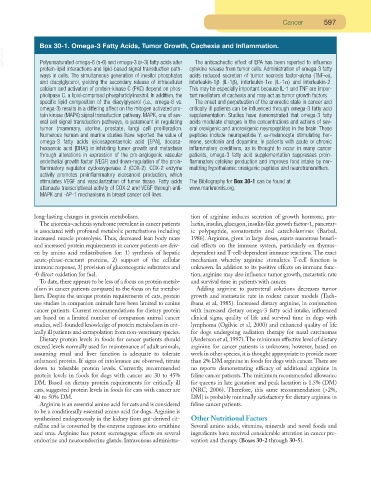Page 576 - Small Animal Clinical Nutrition 5th Edition
P. 576
Cancer 597
Box 30-1. Omega-3 Fatty Acids, Tumor Growth, Cachexia and Inflammation.
VetBooks.ir Polyunsaturated omega-6 (n-6) and omega-3 (n-3) fatty acids alter The anticachectic effect of EPA has been reported to influence
protein-lipid interactions and lipid-based signal transduction path- cytokine release from tumor cells. Administration of omega-3 fatty
ways in cells. The simultaneous generation of inositol phosphates acids reduced secretion of tumor necrosis factor-alpha (TNF-α),
and diacylglycerol, yielding the secondary release of intracellular interleukin-1β (IL-1β), interleukin-1α (IL-1α) and interleukin-2.
calcium and activation of protein-kinase C (PKC) depend on phos- This may be especially important because IL-1 and TNF are impor-
pholipase C, a lipid-comprised phosphatidylinositol. In addition, the tant mediators of cachexia and may act as tumor growth factors.
specific lipid composition of the diacylglycerol (i.e., omega-6 vs. The onset and perpetuation of the anorectic state in cancer and
omega-3) results in a differing affect on the mitogen activated pro- critically ill patients can be influenced through omega-3 fatty acid
tein kinase (MAPK) signal transduction pathway. MAPK, one of sev- supplementation. Studies have demonstrated that omega-3 fatty
eral cell signal transduction pathways, is paramount in regulating acids modulate changes in the concentrations and actions of sev-
tumor (mammary, uterine, prostate, lung) cell proliferation. eral orexigenic and anorexigenic neuropeptides in the brain. These
Numerous human and murine studies have reported the value of peptides include neuropeptide Y, α-melanocyte stimulating hor-
omega-3 fatty acids (eicosapentaenoic acid [EPA], docosa- mone, serotonin and dopamine. In patients with acute or chronic
hexaenoic acid [DHA]) in inhibiting tumor growth and metastasis inflammatory conditions, as is thought to occur in many cancer
through alterations in expression of the pro-angiogenic vascular patients, omega-3 fatty acid supplementation suppresses proin-
endothelial growth factor (VEGF) and down-regulation of the proin- flammatory cytokine production and improves food intake by nor-
flammatory regulator cyclooxygenase 2 (COX-2). COX-2 enzyme malizing hypothalamic orexigenic peptides and neurotransmitters.
activity promotes proinflammatory eicosanoid production, which
stimulates VEGF and vascularization of tumor tissue. Fatty acids The Bibliography for Box 30-1 can be found at
attenuate transcriptional activity of COX-2 and VEGF through anti- www.markmorris.org.
MAPK and -AP-1 mechanisms in breast cancer cell lines.
long-lasting changes in protein metabolism. tion of arginine induces secretion of growth hormone, pro-
The anorexia-cachexia syndrome prevalent in cancer patients lactin, insulin, glucagon, insulin-like growth factor-1, pancreat-
is associated with profound metabolic perturbations including ic polypeptide, somatostatin and catecholamines (Barbul,
increased muscle proteolysis. Thus, decreased lean body mass 1986). Arginine, given in large doses, exerts numerous benefi-
and increased protein requirements in cancer patients are driv- cial effects on the immune system, particularly on thymus-
en by amino acid redistribution for: 1) synthesis of hepatic dependent and T-cell-dependent immune reactions. The exact
acute-phase-reactant proteins, 2) support of the cellular mechanism whereby arginine stimulates T-cell function is
immune response, 3) provision of gluconeogenic substrates and unknown. In addition to its positive effects on immune func-
4) direct oxidation for fuel. tion, arginine may also influence tumor growth, metastatic rate
To date, there appears to be less of a focus on protein metab- and survival time in patients with cancer.
olism in cancer patients compared to the focus on fat metabo- Adding arginine to parenteral solutions decreases tumor
lism. Despite the unique protein requirements of cats, protein growth and metastatic rate in rodent cancer models (Tach-
use studies in companion animals have been limited to canine ibana et al, 1985). Increased dietary arginine, in conjunction
cancer patients. Current recommendations for dietary protein with increased dietary omega-3 fatty acid intake, influenced
are based on a limited number of companion animal cancer clinical signs, quality of life and survival time in dogs with
studies, well-founded knowledge of protein metabolism in crit- lymphoma (Ogilvie et al, 2000) and enhanced quality of life
ically ill patients and extrapolation from non-veterinary species. for dogs undergoing radiation therapy for nasal carcinomas
Dietary protein levels in foods for cancer patients should (Anderson et al, 1997).The minimum effective level of dietary
exceed levels normally used for maintenance of adult animals, arginine for cancer patients is unknown; however, based on
assuming renal and liver function is adequate to tolerate work in other species, it is thought appropriate to provide more
enhanced protein. If signs of intolerance are observed, titrate than 2% DM arginine in foods for dogs with cancer.There are
down to tolerable protein levels. Currently, recommended no reports demonstrating efficacy of additional arginine in
protein levels in foods for dogs with cancer are 30 to 45% feline cancer patients.The minimum recommended allowance
DM. Based on dietary protein requirements for critically ill for queens in late gestation and peak lactation is 1.5% (DM)
cats, suggested protein levels in foods for cats with cancer are (NRC, 2006). Therefore, this same recommendation (>2%,
40 to 50% DM. DM) is probably minimally satisfactory for dietary arginine in
Arginine is an essential amino acid for cats and is considered feline cancer patients.
to be a conditionally essential amino acid for dogs. Arginine is
synthesized endogenously in the kidney from gut-derived cit- Other Nutritional Factors
rulline and is converted by the enzyme arginase into ornithine Several amino acids, vitamins, minerals and novel foods and
and urea. Arginine has potent secretagogue effects on several ingredients have received considerable attention in cancer pre-
endocrine and neuroendocrine glands. Intravenous administra- vention and therapy (Boxes 30-2 through 30-5).

